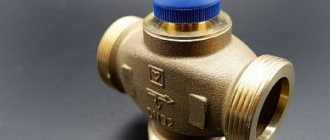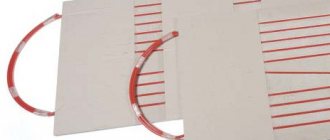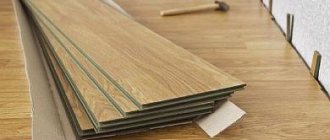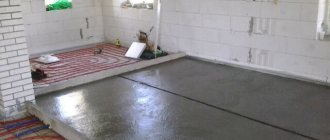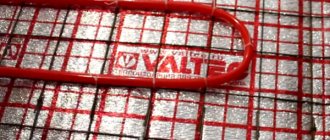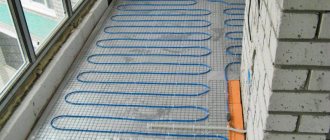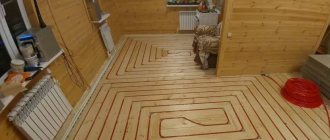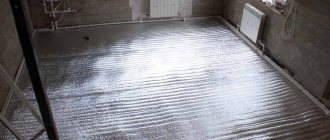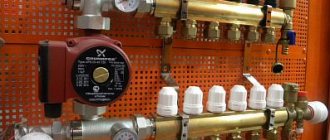When installing heated floors and most types of floor coverings, a special underlay is used, which performs a lot of functions. One of its most popular types is foil for underfloor heating. Some, trying to save on repair work, believe that they can refuse it. However, this step would be a grave mistake. An underlay must be used for installing heated floors.
Foil for heated floors
Laying methods
Let's consider which side is the correct way to lay the insulation with foil on the floor.
Heat-saving properties depend on how correctly the insulation is installed.
Foil reflects infrared radiation, therefore, the metallized layer must be laid so that it faces the inside of the room.
Insulation of concrete floor
Place the casing with the foil side down
Most often, the rolled material is fixed to the concrete base using a special glue made on the basis of rubber.
Installation sequence:
- We prepare the surface. We level the slab so that there is no large difference in height. We seal all cracks and cracks with cement mortar.
- We spread the material on the floor with the foil layer facing up and cut it to the required length. We move the strip aside and apply glue to the place where it is laid. Let it sit for a few minutes according to the instructions for the glue. We lay and press the material well. We place the strips close to each other.
- We secure the joints with foil tape, which is sold in hardware stores.
For additional insulation of cold floors, wooden logs can be laid on top, the space between which is filled with slab insulation. Floorboards or sheet material (OSB, fiberboard, chipboard) are placed on top of it. For an interesting comparison of foil materials, watch this video:
https://youtube.com/watch?v=RgKvM3-JFRU
Wood floor insulation
It is most convenient to lay the material on an adhesive layer
It is most convenient to lay foil insulation on a wooden floor, which has a bottom self-adhesive layer.
If you bought material without an adhesive base, then you need to fix it with staples using a construction stapler or with double-sided tape.
Laying sequence:
- We remove the baseboards, remove debris and dust using a vacuum cleaner.
- If the boards have uneven surfaces, we sand them with a special machine and, if necessary, sand them (remove the top layer of the board).
- We seal all existing cracks with wood putty.
- We prime with an antiseptic composition.
- We measure the room, cut the roll, and lay it up with foil. It can be easily cut to size using sharp sewing scissors.
- Lay out the strips end to end. We wait a day for the material to settle and straighten out. If the heat insulator has a self-adhesive base, gradually remove the protective film and press it tightly to the surface. We lay the next strip end-to-end.
- We fix the joints of the strips with foil tape.
Foil insulation for heated floors
When laying insulation under heated floors, lay the material with the foil facing up so that it reflects heat into the room
The base for heated floors must be flat without differences in height or defects. All errors must be eliminated.
Stages of laying thermal insulation with a layer of foil:
- We lay out the foil material in strips end to end, and glue the joints with special tape.
- We install a system of electric or water heated floors on top.
- We lay hydro- and vapor barrier material. It will prevent concrete from leaking onto the floor heating elements.
- We fill the screed with a thickness of 30-50 mm, depending on the type of heating elements and the functional purpose of the room.
Insulation under floating screed
Having bought a two-layer material, you don’t have to bother with the question of which side to lay the insulation on
It is characterized by the fact that the slab is not rigidly fastened to the concrete screed; thermal insulation is laid between them.
Installation sequence:
- We prepare the base and eliminate all defects.
- We plaster the lower part of the walls.
- We stick damper tape around the perimeter of the walls; its height should be equal to the thickness of the floor: from the slab to the floor covering.
- We prime the base in two layers. Apply the next layer after the previous one has dried.
- We lay thermal insulating foil boards with the foil facing up. We use a metallized coating that is resistant to cement mortar. We lay the slabs strictly in a horizontal plane, close to each other. Uneven laying of insulation boards contributes to the formation of cracks in the concrete solution.
- We glue the joints of the plates with tape.
- We pour the concrete screed.
Lightweight and durable insulation with a layer of foil is becoming increasingly popular among consumers and professional builders due to its high heat retention and ease of installation. For more information about isolation, watch this video:
We looked at how to properly lay foil material for high-quality floor insulation. Thermal insulating material is always laid with foil on the outside; if you lay it the other way around, it will not retain heat fully.
Laying foil under heated floors
Installation work for installing a substrate on a floor with a heating system includes several stages.
Laying the heating cable on foil.
Preparatory activities
When starting to install a backing with foil under a warm floor, you should prepare the tools that will be needed for the work. Need to stock up:
- knife or scissors;
- tape measure;
- aluminum tape.
In addition, you should buy the required amount of the selected type of foil insulation.
Installation on cement screed
Laying the substrate under the heating device is as follows:
- The base is cleaned of dust and debris. If there are uneven spots and cracks on the slab, they are covered with a special solution, which must be dry before installing the backing.
- The reflector is prepared - it is cut to the required length.
- The material is laid from the corner of the room close to the wall, with the reflective surface facing up. Glue is applied pointwise to the base of the mats.
- The following strips are laid out end to end.
- The seams are processed using aluminum tape; this will prevent the formation of cracks, which will ensure high-quality heat and moisture insulation.
Afterwards, you can proceed to laying the heating system and flooring (linoleum, parquet, laminate).
For your information! When installing a cable or water system, you can use any type of insulation: with or without foil, and for infrared - only one with a foil coating.
In addition, when pouring a concrete screed onto a cable or water-heated floor, the quality of the aluminum foil substrate is significantly reduced. After all, when concrete comes into contact with foil, it corrodes it, thereby losing its properties.
Laying on wood
If the base is made of wood, then it is better to take insulation on a self-adhesive film. If you have a regular backing, you can use double-sided tape for fixation.
The working process is as follows:
- The base is prepared: dust and debris are removed. You can sand the surface with a grinding machine.
- To preserve the wood better, it is treated with an antiseptic.
- When the primer has dried, the insulation is rolled out, it usually comes in a roll, and the required size is cut off. The material is laid with the reflective surface up, the protective film is removed, and the insulation is pressed to the floor. The strips are laid at the joint, there should be no gaps.
- The joints are sealed with foil tape.
- The heating elements and flooring material are being installed.
The underlay is a mandatory layer of a heated floor, especially when building a private house or in apartments on the ground floor. And if you use insulation with a foil layer, the system will function much more efficiently.
Types of thermal insulation with foil
Heated floor power per 1 m2 calculation procedure.
Heated floor power per 1 m2 So, on the building materials market you can find a variety of types of thermal insulation materials covered with foil; in particular, it could be:
- foamed polyethylene;
- expanded polystyrene;
- basalt insulation;
- mineral wool;
- multifoil;
- foilisolone.
Let's take a closer look at them. The most popular thermal insulation material used for heated floors is foil polystyrene foam. Quite durable material that is not afraid of sudden temperature fluctuations. In general, it is able to cope with changes in air temperature from -180 to +180 degrees without damage, but, of course, in domestic conditions the floors definitely do not heat up to that extent. Also, polystyrene foam is not afraid of exposure to various chemicals. It is not afraid of rot, various pathogenic microorganisms do not settle on it, which also demonstrates the material as safe for human health.
Mineral wool is purchased and used much less frequently, even with a layer of foil. It is especially not suitable for installing a water heating system. The fact is that in the event of a liquid leak, the material will easily become saturated with it and lose all its qualities - it will not be able to retain heat. And it is not recommended to use mineral wool for electric heated floors. The main reason for negative reviews is that this material, when heated, begins to release substances that negatively affect the body. Therefore, such insulation is often used only in industrial facilities. In fairness, it is worth noting that mineral foil wool also has an advantage - a low fire hazard class.
Foamed polyethylene is another commonly used type of underfloor heating. Durable, plastic, not afraid of moisture, it is not afraid of various chemicals, and pathogenic microorganisms do not settle on it. All these advantages make foil polyethylene one of the best materials for thermal insulation. It can be used both under water heated floors and under electric floors, and its service life can be very long.
On a note! Foamed polyethylene also copes well with such tasks as noise absorption. Its main drawback is the fear of ultraviolet radiation, but under the floor covering sunlight will not reach the material.
Basalt insulation is not used in residential buildings. It is not afraid of sudden temperature changes and can easily withstand from -200 to +700 degrees, which is why it does not burn. This thermal insulation material is used in the aircraft industry.
Folgoizolon is often used in the construction/repair of saunas and baths, as it is not afraid of either moisture or sudden changes in temperature. The service life of the material is quite long, it does not rot, has increased sound insulation properties, and is safe from an environmental point of view. But foil isolon is very expensive, so it is practically not used in residential buildings.
There is another type of thermal insulation with a foil layer. It is known as multifoil and consists of several layers. The foil layer is covered with bubbles filled with air, then polyethylene and polypropylene film are laid. Under the foil layer there is a special protective coating. If you use this type of thermal insulation, heat loss will be reduced to a minimum. In addition, multifoil is not afraid of high humidity.
Attention! When installing a heated floor system, you should not use materials intended for insulating walls and other parts of the building. On the floor they will experience strong mechanical stress, and therefore can quickly lose their properties. Only use materials that are specifically designed for installation on the floor.
Only use materials that are specifically designed for installation on the floor.
Structure of foil thermal insulation material
Most types of foil-coated thermal insulation materials are produced in rolls, which ensures ease of use during installation work.
In general, most insulation materials have a two-layer structure - base and foil. The basis can be:
- basalt;
- mineral;
- polystyrene foam;
- polyethylene.
Each of these materials is environmentally friendly, safe for health due to its inertness, and has excellent fire safety performance. Also, most types of base have a bubble structure, and air, as you know, is one of the worst conductors of heat.
The foil layer is a foil made of aluminum, the role of which is to directly reflect thermal energy. It allows the returned heat to be evenly distributed, but the base prevents it from going into the screed.
On a note! Foil insulation is mostly elastic and soft materials, so the installation process is quite simple.
Due to the fact that most thermal insulation materials with a foil layer can withstand heating up to +90 degrees, such substrates can be used for any type of underfloor heating systems. By the way, on the surface of the foil insulation there are often markings that facilitate the process of laying the cable - you don’t have to constantly fiddle with a tape measure. With this material it is also easier to install a water floor system. Another feature of some foil materials is the sticky layer. It allows you to fix the insulation in one place during installation and will not allow it to move.
Foil insulation and warm floor application features
Which coating is better for a warm water floor?
Most often, foamed polyethylene is used as a base, which allows you to vary the total thickness of the material from 2 to 10 mm. Laying is carried out under the screed as a heat-reflecting and insulating substrate when installing a heated floor. The most popular brands are Izolon, Folgoizol, Ecofol, Isoflex.
If a decision is made to install a water heated floor, often aluminum foil for a heated floor is applied as a coating to foamed polystyrene, which is made in the form of rigid slabs that can withstand fairly large loads and are highly resistant to dampness.
The main advantages of using foil insulation for heated floors are:
- high reflectivity;
- resistance to moisture;
- long service life;
- excellent heat, sound and vapor barrier characteristics;
- fast and convenient installation;
- ease;
- resistance to temperature influences.
When using them, no additional surface treatment with any protective agents is required. They are environmentally friendly and do not contain carcinogenic components. Foil for underfloor heating - the ideal solution
But if it is important for you to take such a step, after weighing all the pros and cons, you need an expert opinion, professional consultation, call. We will be happy to help you
Operating principles of heat transfer
You can understand whether foil insulation is needed inside a residential building by studying the basics of heat transfer and the main principles in its operation. This is a physical phenomenon that occurs through radiation or physical means.
The contact method of heat transfer is characterized by the proximity of a group of objects; through contact they strive to balance and stabilize temperatures. Two surfaces touching each other will, after some time, become of equal heat.
These statements are true in the absence of exposure to external energy sources. Otherwise, heat will be transferred from the coolant to the cold elements of the bond on an ongoing basis.
Heat transfer is inevitable, and when installing a heated floor in a house, the process becomes permanent. Radiation occurs from the hottest body into a cold environment characterized by a lower temperature.
In an air or gas environment, the coolant emits infrared radiation. IR rays do not heat the air, but only physical objects. A layer of air, for example, found in thermal insulation materials, can prevent heat transfer. A thermos works on this principle, inside of which there is a flask in double walls made of glass and a coated mirror.
Laying slab material
Composition of a heated floor cake laid on sand. Installation recommendations and options
Reflective thermal insulation in slabs
Reflective thermal insulation in slabs is installed primarily under heated floors, although it can also be used as regular insulation. With foil mats, make a floating screed and lay them between the joists.
Floating screed
Step 1. The concrete surface of the floor slabs is leveled using putty and grinding. Clean from dust.
Step 2. Using a level gauge, mark the screed pouring line on the walls.
Step 3. A damper tape is attached to the walls around the perimeter of the room and the base is primed.
Kermi damper tapes
Step 4. Plates are taken with a metallized coating, since aluminum is corroded by cement. Glue is applied pointwise to the base of the mats, after which the insulation is laid on the floor with the reflective layer facing up. When laying insulation, carefully adjust the joints so that gaps do not form.
Step 5. The joints are taped, and then the heat-insulating layer is filled with screed mortar. Level the mixture with a wide spatula or rule and leave until dry. After this, you can lay the finishing coating.
Insulation by joists
Step 1. Remove the floor covering, clear the base of debris, check the integrity of the joists, and, if necessary, repair damaged elements.
Step 2. Place waterproofing material on top of the joists and secure it with a stapler on the inside of the beams, spreading the film well on the floor. The edges of the canvases are overlapped by 10-15 cm.
Step 3. The space between the logs is filled with foil plates, laying them in one or two layers. The slabs of the second layer must overlap the seams of the lower layer. A gap of 1.5-2 cm is left between the reflective coating and the upper edge of the logs. If it is not possible to leave a gap, a sheathing of 20x40 mm slats is placed on top of the logs.
Foil basalt mats
Step 4. Further actions depend on the type of flooring. If it is linoleum or laminate, the rough base is covered with sheet material - plywood, chipboard, OSB. If the floor is made of boards, they are placed directly on the joists.
Table of the main properties of foil thermal insulators
Properties
The materials used in production are most often environmentally friendly, safe for health and the environment.
Article on the topic: Gazebos in garden design: a small house for relaxation in the country (35 photos)
Advantages:
- light weight;
- durability;
- resistance to loads;
- protection against moisture penetration;
- high rates of heat saving and sound insulation;
- resistance to temperature changes;
- ease of installation;
- high reflective properties.
Such insulation can be used in any premises. In addition to the described qualities, it is capable of reflecting radiation.
Installation of an electrical cable system using a substrate
The preparatory work before installing the heating model is identical to the installation work of an infrared heated floor. The installation itself is performed in the following sequence:
- Slab polymer insulation is placed on the clean base of the room.
- Vapor barrier layers are laid over the entire area of the room.
- Install a polymer bedding.
- The plastic mesh is installed.
- Cables are secured to it using polyethylene clamps.
- Fill the screed.
The floor covering is installed on the hardened concrete.
It is not recommended to carry out this installation work yourself. It is better to invite an experienced specialist to carry them out. Since mistakes made can not only affect the family budget, but also damage heating systems.
Which is the best underlay for laminate? Corporate approach
Tuplex branded underlay may be the ideal solution to the issue of choosing underlay for laminate flooring. It has a thickness of 3 mm, is made in the form of two layers of film, the internal space between which is filled with granulated polystyrene. It removes moisture well, protects against the formation of fungus, and is convenient to use, but its price encourages you to choose similar materials from other manufacturers.
Also easy to use, the backing for polystyrene laminate is produced in the form of small sheets measuring 60x120 cm and is in no way inferior in quality to its cork counterparts. Moreover, polystyrene better smoothes out unevenness of the screed, can even be laid on top of wooden floors, has a high noise absorption coefficient, promotes thermal insulation, but... is short-lived compared to cork. Over time, it loses its elasticity and after 6-10 years it becomes useless in terms of supporting the laminate. In addition, polystyrene is very dangerous when burned; it emits abundantly caustic and poisonous smoke.
Polystyrene laminate backing photo
There are cases when laminate is laid on top, where, in principle, there cannot be any moisture, however, a lining is needed. The underfloor heating for laminate flooring must conduct heat, so cork and polystyrene will be ineffective. There is a special underlay for arbiton heated floors; its perforated (small hole) sheet allows heat to pass through freely, while also performing its main function - supporting the laminate.
It is also possible to use a polyethylene backing without foil; in extreme cases, you can simply lay corrugated cardboard; on a warm floor, where there is no moisture at all, this method also works. Since laminate itself conducts heat very poorly, it is necessary to use samples specially made for heated floors.
As you can see, the choice of underlays for popular flooring is wide, so it is difficult to say which underlay is best for laminate; it is better to listen to what laminate manufacturers say and choose the type of underlay that they recommend.
Optimal substrate options
Each insulation manufacturer advertises its products in every possible way, trying to increase its demand. Therefore, you should not listen to the demands that they put forward. The following indicators are considered the optimal solution when choosing.
Thermal conductivity
The lower these indicators, the better the performance of the substrate. This parameter depends on the material being manufactured, as well as on its thickness. To increase the heat supply rate, the underfloor heating substrate must have a foil layer that will reflect infrared rays. And also for these indicators, the manufactured material must have strength and resistance to static and dynamic loads, be environmentally friendly, have resistance to temperature changes and resistance to deformation.
Manufacturability
To facilitate installation work, the lining should be made of lightweight materials that will not exceed a thickness of 5 millimeters and can be easily cut with scissors. Foamed polystyrene foam is considered one of these materials, as it is more technologically advanced to use. Insulation made from it is flexible, which certainly makes it easier to arrange the joints between the bases of rooms and walls. If you choose sheet plywood or chipboards, installation work will take a lot of time, since it will be more difficult to fit them in these places.
Relieving qualities
To simplify installation work, some manufacturers mounted protruding bosses or drew a mesh on the surface of the insulation. Thus, when installing in a water system, they can be fixed simultaneously with the gasket. This in turn improves the efficiency of the heating system itself.
Environmental friendliness
Basically, many of the materials from which substrates are made release harmful chemical compounds into the air under heated floors. Therefore, when choosing, you need to familiarize yourself with their composition. The material used must pass all safety requirements.
Having familiarized yourself with the general information, it is necessary to consider what types of underlying materials are best used for a particular heating model.
Criterias of choice
When choosing foil mats for laying a heated floor system, take into account the following material characteristics:
- ability to reflect thermal energy;
- coefficient of thermal conductivity;
- resistance to high temperature loads;
- noise absorption properties;
- reaction to a humid environment;
- environmental Safety;
- fire hazard class;
- ease of installation.
An equally important criterion for choosing a heat flow reflector under a heated floor is the cost of the product. Thus, polyethylene foam with aluminum coating is sold in the affordable segment, as is polystyrene foam heat insulator with a reflective surface. To construct a substrate made of multifoil or foil-isolon, you need to pay a significant amount. Basalt mats or other types of mineral insulation are inexpensive, but products in this category are not suitable for heated floors due to their composition.
The thickness of the reflective layer is also of great importance. If a simple spraying is performed on top of the thermal insulating layer, this causes a low level of efficiency of the substrate. It is worth remembering that the lower the quality of the reflector, the easier and more intensely thermal radiation leaks through it.
Aluminum foil - features of the use of thermal insulation
Thermal insulating aluminum foil is a modern building material designed to retain heat by screening thermal energy back into the room. Due to its porous structure, this material has low thermal conductivity, which allows it to be used not only as a screen, but also as insulation.
What is aluminum foil for thermal insulation?
This material most often consists of two layers:
- The base is made of foamed polyethylene, extruded polystyrene foam or mineral wool, which serves as additional insulation.
- An additional layer of special aluminum alloy, which fully reflects the visible spectrum of thermal energy and blocks up to 90% of infrared radiation.
There are also types of thermal insulation made from one foil - it is used for chimneys, baths, saunas.
Operating principle of aluminum thermal insulation
The principle of heat conservation using this type of insulation is very simple. Due to the presence of a large number of air bubbles in the structure of the main layer of foamed polyethylene foam, the material, based on the “thermos” principle, retains heat for a very long time. And thanks to a special aluminum coating, all heat from energy radiation sources (heating radiators, convectors, air conditioners, etc.) does not pass through the thermal insulation, but is reflected and returned back to the room.
Where is aluminum foil used for thermal insulation?
This material, thanks to its excellent technical characteristics, is used in construction and installation work (construction and installation works), namely:
- For insulating walls before laying mineral wool insulation, extruded polystyrene foam or liquid insulation.
- When installing the “Warm Floor” system to reflect infrared rays and thermal energy into the room.
- When installing a vapor barrier for the roof and rafter system.
- When insulating ceilings made of plasterboard, OSB or suspended ceilings in multi-storey apartments, private houses or cottages.
- As a substrate for laminate or parquet.
- For thermal insulation of hot water supply and heating pipes.
- During the construction of baths, saunas or boiler rooms (self-adhesive thermal insulation).
- When installing a centralized ventilation and air conditioning system in industrial and semi-industrial premises.
This list can be continued indefinitely, but let’s try to answer the question: “Why has aluminum thermal insulation earned such popularity?”
The main advantages of aluminum insulation
- Environmental friendliness of the material. Foil insulation is made from food-grade aluminum foil, which meets all sanitary requirements.
- Energy efficiency. With proper installation, heating costs can be reduced by 40-60%.
- Big choice. Depending on the need, foil insulation is manufactured with a thickness of 2 to 20 mm.
- Compliance with fire regulations. Thanks to the use of special components that are added to the main layer of insulation, the material is flame retardant.
- Effective work in extreme conditions. This material can withstand temperatures up to 1200C, making it ideal for thermal insulation in baths and saunas.
- High ductility and elasticity (self-adhesive foil). Aluminum polyethylene foam backing can stretch and shrink without losing its properties, which allows it to be used to protect laminate, parquet or linoleum flooring.
- Anti-corrosion property. This material is absolutely not susceptible to corrosion, so it can be used in rooms with high humidity.
conclusions
Aluminum foil for thermal insulation is a reliable and effective insulation for any room, which is characterized by:
- excellent technical characteristics;
- increased fire safety;
- long and reliable service life.
Application
But, although it is still possible to create the desired temperature, maintaining it at a certain level is not always possible. This is where insulation comes to the rescue.
In order to make a good thermal insulation for a steam room, you need to choose the right type of insulation. The market will offer many types of insulation, but not every type of insulation is suitable for a steam room, as for the entire bath. High humidity and temperature will negate the properties of many insulation materials.
But, despite the harsh environmental conditions, there is a choice. To make the right choice, you need to understand what role the insulation should play.
There are few of them:
- Firstly, the main thing is to keep warm. To do this, it is enough that the insulating material acts as a heat reflector and has low thermal conductivity.
- Secondly, insulation must be durable, environmentally friendly and affordable. Aluminum foil meets all these requirements. It has proven itself much better than traditional insulation materials such as roofing felt, glass wool, glassine and a number of others. Judging by the reviews of those who have already insulated their baths and saunas with foil, the best heat insulator does not yet exist in nature. The photo shows a sheet of foil-isolon. When installing thermal insulation sheathing, it is successfully used not only for insulating walls. It is possible, and even desirable, to insulate the ceiling. Thus, if you cover the walls and ceiling of a bathhouse with this insulation, then the issue of heat loss will be resolved once and for all.
In construction practice, there is another method of insulation using aluminum foil. Insulation is made using traditional materials, but a layer of aluminum foil without lining is spread over the top. But, given the “delicacy” of this material, it is advisable to purchase foil with a lining, for example, made of fabric.
If you cover them with aluminum foil, the insulation effect will increase significantly. In this case, the foil will create a reflective effect and the heat in the room will be reliably retained. And the layer of insulation located below will hold it in place.
The foil is attached to the insulation using buttons, furniture nails or using a stapler. The joints of sheets or strips are additionally glued with construction tape or aluminum tape. Whether this is worth doing is still an open question.
Some experts are against sealing joints, citing the fact that when heated, the adhesive tape releases toxins, to put it mildly, which are not very healthy. In their opinion, it is necessary to overlap the joints when installing them. But here, as they say, as many builders as there are so many opinions. One thing is known for sure - the heat-reflecting ability of the foil does not decrease from the method of sealing joints.
Types of thermal insulation
Penofol
Penofol is produced and sold in the form of rolls.
Penofol is foil-coated polyethylene foam. It is a soft and flexible material produced in rolls.
Thermal conductivity coefficient is 0.037 – 0.052 W/m×°C.
Penofol is easy to install and easy to cut. The foil layer effectively distributes heat over the entire surface of the heated floor.
However, this material also has a drawback: under the weight of the screed and floor covering, it can shrink, while the volume of air bubbles included in its structure will significantly decrease, which will entail a loss of thermal insulation qualities.
Important! As a rule, this material is used on the upper floors of apartment buildings, where there is a warm heated room under the heated floor, and the floor slab is sufficiently heated
This material is not suitable for basements and first floors, as well as balconies and loggias, basements and garages.
Sometimes, however, it is not possible to raise the floor a significant distance, then the use of penofol may be justified.
This material is not suitable for basements and first floors, as well as balconies and loggias, basements and garages. Sometimes, however, it is not possible to raise the floor a significant distance, then the use of penofol may be justified.
Advice! When choosing floor insulation, look for foil materials with an aluminum foil thickness of at least 30 microns. We are not interested in lavsan coatings with reflective properties, only thick foil!
Cork tree
Balsa wood insulation is sold in rolls, sometimes in the form of mats or slabs.
The thermal conductivity of balsa wood ranges from 0.035 – 0.05 W/m×°C. As you can see, this characteristic is comparable to that of penofol.
However, it is believed that a layer of cork 2–3 mm thick is sufficient to insulate a heated floor. This is certainly a controversial opinion.
The advantage of cork insulation is its naturalness. It consists of absolutely natural raw materials and does not emit toxic chemicals under any conditions.
However, there are also disadvantages:
- high price of material;
- the possibility of rotting, a breeding ground for fungi and mold;
- damage from biological corrosion;
- the cork needs waterproofing.
Therefore, for cork wood we can also conclude that it is only suitable for floors with minor losses and warm heated floors. More often, cork is used as a substrate for laminate flooring.
Expanded polystyrene
Foiled polystyrene foam for thermal insulation of floors with markings.
Expanded polystyrene is the most acceptable option for thermal insulation of floors.
This is caused by a number of reasons:
- The material has a density sufficient for laying under the screed - more than 35 kg/m³;
- Expanded polystyrene slabs have sufficient thickness - 50 mm, thanks to which you can easily arrange effective 100 mm thermal insulation of the floors of basements and basements, first floors, etc.;
- The material has low thermal conductivity - 0.039 W/m×°C, which with a layer of 50 - 115 mm provides complete insulation and reduces heat loss to nothing;
- Expanded polystyrene for floors is covered with a laminated layer of foil from 30 microns thick, which makes this type of insulation optimal;
- The installation instructions suggest simple DIY work, and markings on the foil make it easier to install the heating elements;
- The slabs do not shrink under the weight of the screed and maintain stable thermal conductivity for many years;
- Polystyrene is chemically inert to solutions of salts, acids and alkalis;
- The material is biologically inactive and is not food for living organisms or a substrate for fungi;
- Does not change parameters and does not emit harmful chemicals in the temperature range from – 180 to +180 ° C.
Advice! When purchasing a thermal insulator based on polystyrene foam, look for flooring material, since facade and other configurations may not be suitable for working near heating elements and emit harmful substances or change their parameters and shape.
Expanded polystyrene is especially convenient for warm water floors if it is equipped with special locks for securing the tubes.
Important! According to most experts, extruded polystyrene foam with a density of 35 kg/m³ is the best means of thermal insulation for heated floors, especially on the ground floors and in the case of unheated rooms below
Briefly about the main thing
Reflective insulation works according to a special principle based on a layer structure. The main layer consists of a porous or fibrous material; on top (sometimes on both sides) it is complemented by a layer of aluminum foil or metallized film.
It is the shiny surface that does the main job of retaining heat in the room. Additionally, it serves as a steam, hydro and sound insulator, and if the installation technology is violated, it causes the appearance of a thermos effect.
Common foil materials include polyethylene foam, basalt and glass wool, and foil polystyrene foam. To fix the material on the surface, you need a stapler or dowels; the joints are fixed with aluminum adhesive tape.
Advantages and disadvantages
As mentioned above, a substrate with a foil surface is an excellent material for saving energy. In addition, foil has a number of other advantages, but there are also disadvantages.
| pros | Minuses |
| Does not affect the height of the floor, since the foil material is only 2-10 mm thick. | High cost is the main disadvantage. |
| It is not difficult to install, so even an inexperienced person can handle the job. | It is not recommended to use a mineral substrate with a metallized layer for heated floors, since toxic substances are released during the heating process. |
| It has soundproofing and waterproofing properties. | Using such a substrate in rooms with high humidity significantly reduces its service life. A foil-coated product is recommended. |
| Withstands heating up to +90 degrees and more. | Dissolves upon direct contact with cement. |
| Most products with foil are equipped with markings, which simplifies the process of laying heating elements. | |
| There are models with a sticky layer, this makes installation easier. | |
| Reduces heat loss and promotes its uniform distribution. |
It should be noted that the foil product is strong and durable if installed and used correctly.
Foil for underfloor heating - is it necessary?
A substrate with foil when installing a “warm floor” system is today one of the integral parts of the heating pie. Insulation with a foil layer most effectively saves the heat generated by the heating device and distributes it evenly.
This helps save heat resources, increases the potential of the heating system and the rate of heating the room, which in turn affects the life of the floor.
For your information! It is believed that using foil material in an electric warm cake is not safe, but this is misleading. Today there are many protective and insulating materials available.
The structure of the foil substrate includes a base and a foil. The base can be: basalt, mineral, polystyrene foam, polyethylene. Most of these thermal insulation products have a bubble structure. The surface of the foil for heated floors can be aluminum or metallized.
Installation
Measurements Installation of the underlay for a heated water floor should begin with measurements of the room in which heated floors need to be installed
When taking measurements, it is important to take into account that film and foil mats are sold in rolls, while all others are mainly sold in slabs. At the measurement stage, your task will be to minimize the length of the joints and, based on this task, you need to select the width of the rolls or the width and length of the mats for the underfloor heating.
Preparing the load-bearing surface At the next stage, the floors need to be cleared of debris and uneven surfaces
This will allow the substrate material to be distributed more evenly in the next step.
Laying the material The substrate material must lie freely and without tension.
To prevent roll materials from creasing, it is better to use a long, but not heavy load, such as a block.
Gluing The joints of the substrate should be glued before laying pipes and screeds; aluminum tape, or its cheaper analogue - metallized tape, is best suited for this purpose.
Nuances of fastening and installation
Installation of insulation is not difficult; it is easy to cut and install. The work on the outside and inside is almost the same.
Main nuances:
- the surface on which the insulation is placed must be clean;
- the material is straightened so that it is smooth, without wrinkles;
- foil prevents heat from escaping, so it is laid with the outer side up;
- the insulator is glued end-to-end, the joints are taped;
- If the insulation does not have a self-adhesive layer, use special glue.
It is important that the glue used for fastening does not emit harmful substances and holds the material firmly
Walls
The slabs are mounted using dowels on vertical surfaces.
Installation of insulation to the wall must be thoroughly thought out. An air gap is left between the material and the subsequent finishing to avoid condensation.
- The membrane is fixed and the insulator is rolled out on top of it.
- The material is fixed with slats. Their thickness should be greater than the main insulation.
- Along the edges of the slats, the insulator is connected with staples.
- The panels are finished over the slats; their thickness provides the necessary air gap.
Setup No. 2
The tiles ordered from a large Cypriot company were not delivered on time. The manager met our user (an experienced builder who worked with dozens of companies in Russia) with excellent coffee and vague excuses. Why, he was spinning around like he was in a frying pan: he was lying right to his face about moving, about the fact that it was impossible to find out which of the two warehouses the tiles were in now. Sodrujestvo needed to get the tiles as quickly as possible:
SodrujestvoFORUMHOUSE Member|
“Where are the tiles?” “In Nicosia. But the company is now moving. Therefore, it is unknown which of the two warehouses.” “Okay, I’m going to Nicosia tomorrow anyway. Give the addresses of the warehouses and warn me that I will come and pick up 10 meters.” I gave him the address, I entered it into the navigator, and the manager checked it. The next day my wife and I arrived in Nicosia. At the specified address there is an open field, no warehouses.
After long nervous calls and negotiations on the verge of normative vocabulary, it turned out that there were no tiles in Cyprus, they found a replacement no worse than the ordered one, but an unpleasant aftertaste remained.
How to lay the tiles: apply a 5-6 mm primer onto the galvanized sheets with a roller, wait until it becomes transparent (you had to wait about half an hour) and lay the tiles on the tile adhesive. The work was standard, there were no special features or surprises.
The best substrates for laminate flooring made from natural materials
Steico Underfloor - coniferous tiles
Substrate made of pressed softwood with thicknesses of 3, 3.6, 4, 5.5 and 7 mm. The ideal option is if there are warm water or electric floors under the coating. For better thermal conductivity and heating operation of underfloor heating, perforations can be made in the slabs. A completely environmentally friendly product with high noise insulation properties. With such a damping layer, the cheapest loud laminate becomes completely silent.
Advantages:
- natural product;
- absorbs all sounds;
- absorbs moisture, protecting the panels;
- does not cake;
- affordable price.
Tarkett - cork
It is not for nothing that the brand is associated with high-quality cork base for laminate flooring. Tarkett cork 1.85 mm in rolls does not deform. You can see photos or videos where people, many years later, open the coating to replace it, and the backing is simply in perfect condition. Durability and predictable quality are the main advantages of a product that is worth the money.
Advantages:
- environmental friendliness;
- ease of installation;
- proven strength and durability;
- excellent sound insulation.
Flaws:
- thin;
- need waterproofing;
- overpriced compared to similar products.
Premium Cork - roll cork backing
Advantages:
- high-quality and durable product;
- reputable European manufacturer;
- good heat and sound insulation;
- A 3 mm layer can slightly smooth out the unevenness of the base;
- for rooms with high traffic.
Flaws:
- expensive material;
- You need a film on the base.
Parkolag 3 mm - cardboard-based cork
An innovative product that combines bitumen waterproofing and environmentally friendly damping materials: 2 or 3 mm cork chips and cardboard. Laying occurs with the cork side down to protect the panels from moisture. The crumbs, soldered into the bitumen layer, do an excellent job of sound insulation and shock absorption. Professional craftsmen and owners of houses that are built “to last” love to work with the products.
Advantages:
- all ingredients are 100% natural;
- protection from moisture, dampness, cold;
- dampens noise;
- does not miss;
- recommended by masters.
Flaws:
- price;
- the smell of bitumen appears when the floor is heated, for example from the sun;
- Therefore, it cannot be installed with heated floors.
Isoplaat - coniferous soundproofing underlay
Green thick slabs, judging by the reviews, have won the love of owners of private houses, because... they are most often purchased for laying coverings on subfloors. Helps level out differences in height. Suitable for leveling and for laying out heated floors. The best type of underlay for sound insulation in apartment buildings. In addition to absorbing sound, such a wood board retains heat well.
Advantages:
- environmental friendliness;
- several standard sizes in thickness from 3 to 7 mm;
- maintains density and does not spoil the locks of the boards;
- suitable for warm floors;
- absorbs all noise;
- relatively inexpensive product.
Flaws:
- thin sheets 3 mm, very brittle;
- there is a lot of dust after work;
- green color is a natural paint, but it fades and fades;
- need waterproofing.
Arbiton Cork 2 mm - cork, for heated floors
The Polish brand Decora produces inexpensive rolled cork backing, which is a compromise between price and quality. Suitable for laying laminate flooring in rooms with a flat base, for large areas. Thin material requires careful handling and mandatory duplication with a waterproofing film.
Advantages:
- environmental friendliness;
- protects against cold;
- noise insulates;
- Suitable as one of the layers under heated floors.
Flaws:
- fragile edges;
- not suitable for uneven ground;
- A film for waterproofing is required.
We carry out installation
As an example, let’s look at the installation of film heated floors.
There are following instructions:
- We lay the thermal insulation substrate on the cement base.
The underlay under the laminate for heated floors is laid end-to-end. In this case, the sheets are connected to each other using tape.
- We place a heating film on top of the substrate. The strips should not intersect or overlap.
Heated floor elements must be laid at a distance of at least 100 mm from the walls. In this case, the area covered by the film must be at least 70% of the area of the room.
Laying film under furniture is prohibited! Marks along which the film can be cut are present on the canvas every 20-30 cm.
- Electric heated floors made from films use a parallel connection circuit. For this purpose, special clamp-contacts are made. By crimping they are connected to copper busbars. In this case, the contact point on both sides is insulated using bitumen insulation (supplied in the kit).
In order to install the strips, a stranded copper wire with a cross-section of at least 2 square meters is used. (assuming the current is 16-20 A).
Correct laying of the film layer on top of the penofol.
- The temperature sensor is being installed. We do it this way: we cut off a strip of bitumen insulation and glue the temperature sensor under the heating film near the thermostat.
- Check the functionality of the heating elements. To do this, the system is turned on for 15 minutes.
- A layer of vapor barrier must be laid on top of the heating surface. It is represented by ordinary polyethylene film.
Laying a vapor barrier layer.

